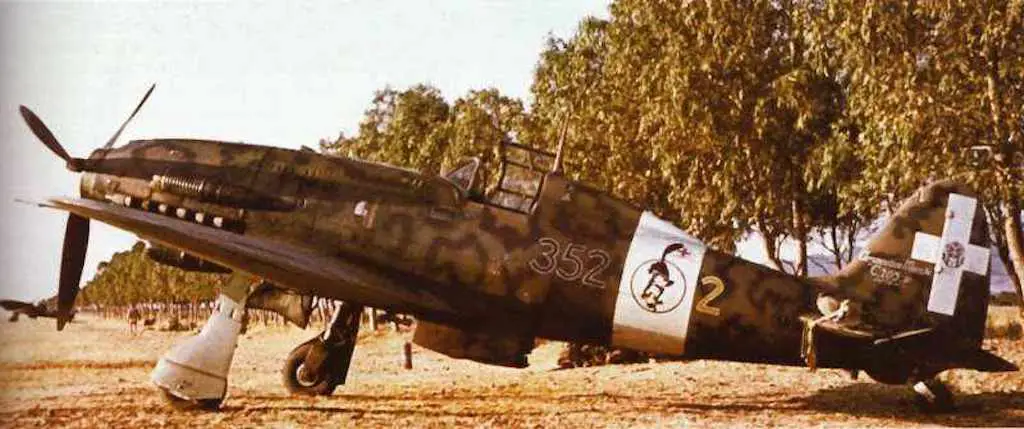Background on the Macchi C. 205 Veltro ‘Greyhound’
Italian aircraft development during the first half of the 20th century somewhat resembled a rollercoaster. Italian military aircraft were world-class during the ’20s and early ’30s. With the delay in adopting the all-metal monoplane, they ceased to be competitive as the Second World War began. Production of the Macchi Castoldi series – the MC. 200, the MC. 202 and Macchi C.205 – designed by Mario Castoldi, went a long way to rectify this.

The C.205 Veltro without a unit designation.
The Macchi C.200 Saetta remained somewhat inadequate, due to light armament and a weak powerplant. The frame formed the basis of the more powerful MC. 202 Folgore (int. 1941), one of the formidable fighters of the war. While the Regia Aeronautica had reestablished a semblance of parity, the three ‘Serie 5’ fighters offered hope of superiority. They were distinct airframes, built to house the Daimler-Benz DB 605 engine. The tried and true Macchi C. 200/202 frame was made to accommodate the engine, resulting in the Macchi C.205 Veltro, one of the finest fighters of the war. The few built arguably represented the pinnacle of Italian aircraft design, which came crashing down with the Armistice of 1943.
Characteristics
Like its predecessors, the Macchi C.205 Veltro was a single-seat fighter with a crew of one. The wingspan measured 10.58 meters from end to end, with a wing area of 16.8 m2. The length of the fighter reached 8.85m, and it stood slightly taller than predecessors, at 3.04m. When empty, the MC.205 Veltro weighed 2,581 kg. When combat-ready, it weighed 2,581 kg. and could take off at up to 3,900 kg. The armament represented a leap forward over previous designs; while the Macchi C.205 Veltro mounted the traditional dual 12.7mm machine guns, it also carried two 20mm gun pods. While it was possible to install 20mm gun pods on the MC. 202 Folgore, the loss of performance was intolerable to Regia Aeronautica leadership.

Macchi C.205V, Serie I from 352ª Squadron, 51° Stormo, parked at Capoterra, Sardinia, in the summer of 1943.
The key, however, was the Fiat RA.1050 R.C.58 ‘Tifone’, a licensed variant of the DB 605 V-12 inverted liquid-cooled piston engine. The 1,475 hp engine produced sufficient power that the Veltro improved dramatically in both firepower and performance. In addition to the improved firepower, the maximum speed increased by 40 km/h, reaching 642 km/h. The range grew to 950 km, and the Veltro retained the fantastic performance characteristics of the predecessors. The plane was deeply beloved by those who flew it and held in good regard by those who found themselves fighting it.
Veltro Service History
On April 19, 1942, the Veltro took its maiden flight. By February 1943, the MC.205 made its combat introduction as the first planes reached combat units. Due to the scarcity of it and the other ‘Serie 5’ fighters, the best pilots received priority. Adriano Visconti, Italy’s leading ace, managed to defeat four Allied fighters in the four months he flew the Macchi C.205. Luigi Gorrini, the leading C.205 ace claimed 11 kills during the summer of 1943 in the defense of Rome. Due to the intensified bombing of Italy and the Italian capitulation, they never rectified the shortage of first-rate fighters.

Ace pilot Adriano Visconti in the Veltro.
Of all production runs, Macchi completed 262 of the MC.205 Veltro planes. However, the near-interchangeability of the Castoldi airframes meant that some Macchi C.202 Folgore units had a Veltro engine installed. In this way, they became ‘pseudo Veltro’ fighters, distinguishable by their poorer armament and better performance. Of these, only 66 had been assigned to squadrons at the time of the armistice. Most served with the Regia Aeronautica and the post-armistice Aeronautica Nazionale Repubblicana. The Luftwaffe appropriated some of the units for themselves. As the MC. 205 Veltro was a plane capable of fighting heavy bombers and the P-51 Mustang effectively, units were invaluable in 1944. Additionally, small numbers arrived for service with the Croatian Air Force.

A Macchi C.205 Veltro of the 360th Squadron, 51st Stormo in Sicily in the Summer of 1943.
After World War Two
After the conclusion of the war, newly-independent Egypt purchased an order of Macchi C.205’s. Most planes originated as refurbished C.202’s, and both up-engined MC.202’s and proper MC.205’s fought in the 1948 Arab-Israeli War. By this time, they had already been retired from Italian service, being decommissioned in 1947. They persisted a little longer in the Egyptian Air Force, where they saw use until 1950. Three Veltros survive to the present day, located at the National Museum of Science and Technology and the Museo storico dell’Aeronautica Militare.

Specifications
| Model | Macchi C.205V |
|---|---|
| Crew | 1 |
| Powerplant | (1) Fiat RA.1050 R.C.58 Tifone 1,475 hp |
| Maximum Speed | 399 mph (642 km/h) at 7,200 m |
| Max Ceiling | 37,700 ft (11,500 m) |
| Range | 590 miles (950 km) |
| Length | 29 ft (8.85 m) |
| Height | 10 ft (3.04 m) |
| Weight | Empty: 5,690 lb (2,581 kg) Max: 8,598 lb (3,900 kg) |
| Wing Area | 181 Sqft (16.8 m2) |
| Wingspan | 34 ft 9 in (10.580 m) |
| Armament | (2) 12.7 mm Breda SAFAT machine guns (400 RPG) under fuselage (2) 20 mm cannon, 250 rpg, in wings (2) 350 lb (160 kg) bombs |
